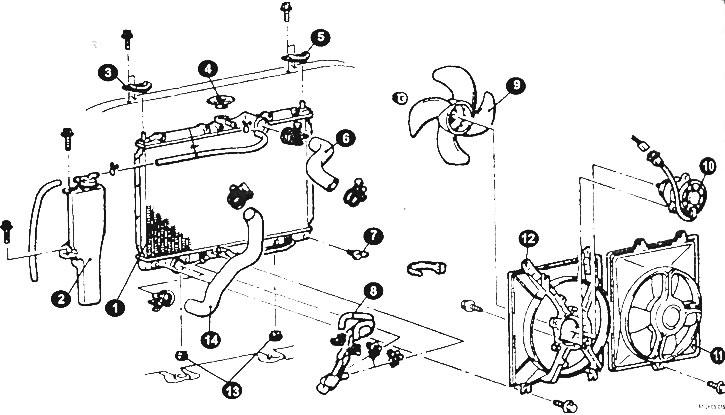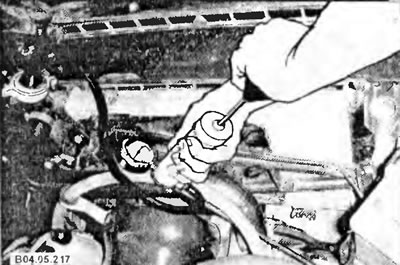
Radiator mounting elements
1 - radiator; 2 - expansion tank; 3, 5 - upper radiator support; 4 - radiator cap; 6 - upper radiator hose; 7 - drain plug; 8 - automatic transmission cooler hose; 9 - radiator fan; 10 - radiator fan motor; 11 - condenser fan (models with air conditioning); 12 - radiator fan casing; 13 - lower radiator support; 14 - lower radiator hose.
The only reason to remove a radiator is to replace it with a new one or repair a leak. If the radiator requires constant topping up of fluid, and no leak can be found in either the hoses or the radiator, the radiator cap may be the culprit. However, if the cap was defective and you replaced it, continue to monitor the fluid level. The system is under pressure again and leaks can occur quite suddenly, so it is necessary to periodically check the pressurized system. The figure shows one of the verification methods.

If the radiator cap is in good condition, but the coolant is still decreasing, with no visible leaks from the outside, the problem is really serious. This may be caused by a defective cylinder head gasket. At this stage, you should consult a specialist.
If the radiator is leaking, replace it with a new or remanufactured one. If the radiator has been repaired by the owner or a workshop, it should be pressure tested at least 1.4 kg/cm2. To do this, close the outlet channel with a suitable plug and through the other channel supply compressed air to the radiator at a pressure of 1.4 kg / cm2. Immerse the radiator in a bath of water at 90°C. Leave it for 15 minutes and pressurize again to 1.4 kg/cm2. Watch for bubbles indicating leaks. If the radiator has not been tested after a pressure repair, it should be monitored very closely for several weeks after installation in order to detect possible leaks in time.
Removing
Drain the coolant as described above.
Loosen the upper radiator hose and lower radiator hose clamps and remove them.
Disconnect the hose from the expansion tank.
Disconnect all electrical wires from the radiator fan and fan on sensor.
Disconnect the cooling system pipes preventing the radiator from being removed from the vehicle.
After unscrewing the top mounting bolts, remove the radiator together with the radiator fan (not all models).
Remove the radiator from the engine compartment by first removing it from the lower radiator mounts.
Flushing
Flush the radiator If the radiator is removed from the vehicle, flush it in the opposite direction as well. Rinse the outside of the radiator with a hose with a strong jet of water. If you suspect that the radiator is partially clogged, flush it with a chemical solution before removing it from the vehicle. If nothing has changed, check if the water passes through the radiator normally. In half a minute, 20-25 liters should pass.
Leaks can be temporarily eliminated by using special additives to the coolant or by covering part of the radiator with special mastic. However, it is better to replace the radiator.
Installation
The radiator is installed in the reverse order.
Check for cracked hoses, replace if necessary.
